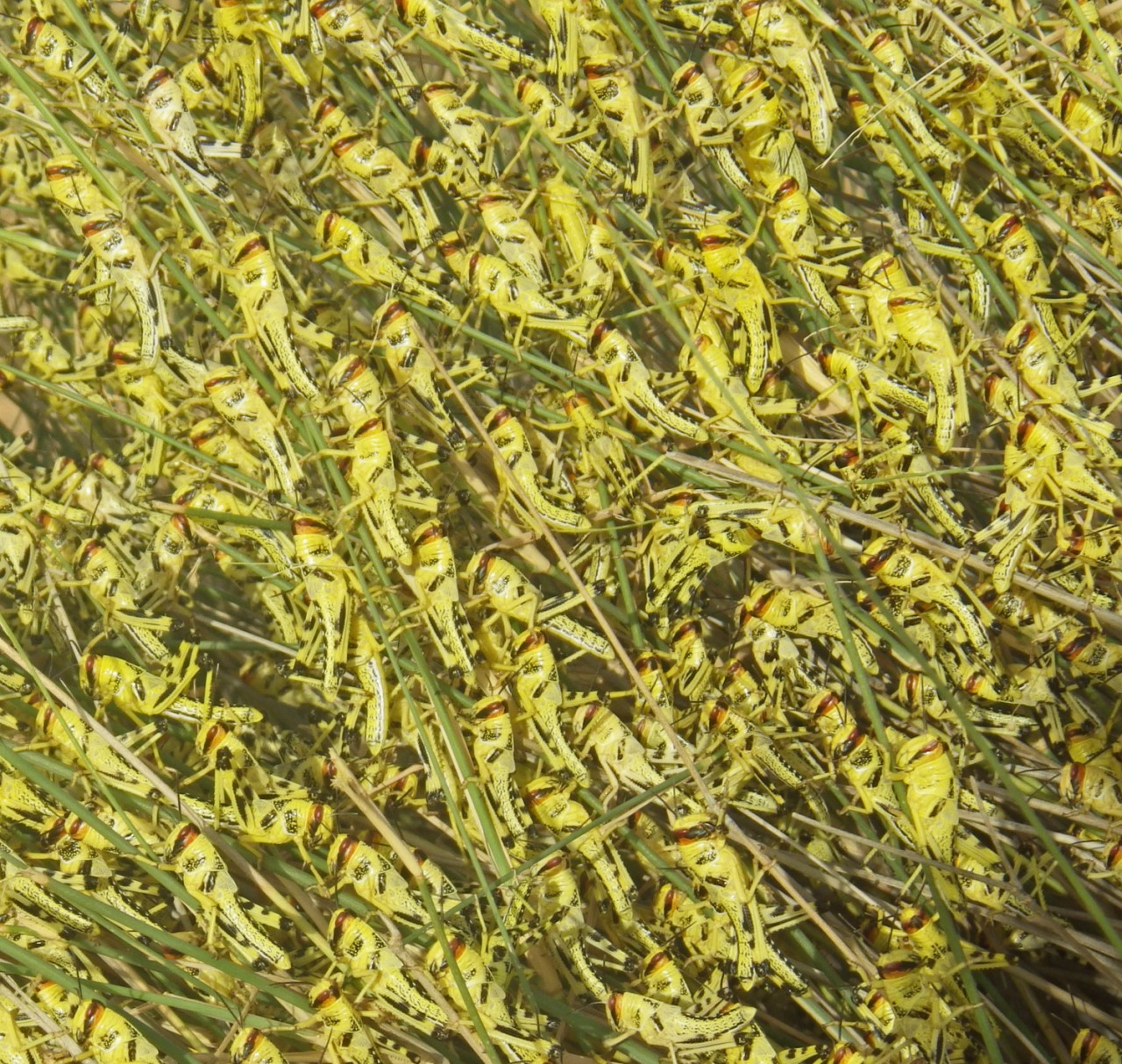Pick Up
2. Towards the development of preventive control technologies for desert locust

The desert locust, Schistocerca gregaria, is now raging across East Africa, the Arabian Peninsula and the Indian-Pakistan border, causing a serious food crisis (FAO Desert Locust Bulletin No. 497). This locust has often caused serious damage to crops. A massive desert locust swarm is large enough to invade the entire Tokyo area. The damage caused by this locust affects almost 10% of the world's population and 20% of the earth’s surface. The total annual damage is feared as a global natural disaster of more than 40 billion yen in West Africa alone. Currently, it is feared that the new coronavirus epidemic will also occur which will greatly hinder support activities in affected countries.
The desert locust is normally a harmless insect, but when the number increases and individual locusts stimulate each other, the physiology, ecology, morphology, and behavior change and it transforms into a serious pest and can be mistaken for another species. At a low population density, desert locusts exist in disperse solitarious phase generally referred to as green locusts. Under high density associated with outbreaks, population growth occurs in a gregarious phase with the nymph changing in color to yellow and black, and the adults from brown to red or yellow. This phenomenon is called phase polyphenism. At the time of a huge outbreak, desert locusts aggregate into a swarm and move over 100 kilometers a day. The number of individuals explosively increases in a short period of time and continue to move. Polyphenism gives rise to outbreaks and the images usually shown in the news are desert locusts which have already become gregarious phase.
Until now, elucidation of the mechanism of polyphenism is thought to lead to the management of desert locust population, and a great deal of research has been conducted mainly in Europe over the past 100 years. However, the mechanism in the field remains unknown mainly because previous researches were conducted in laboratories in areas where this species does not live and lacking essential information on ecology in the field. Therefore, utilizing its vast experience in overseas research activities, JIRCAS is conducting research in collaboration with the Mauritanian National Anti Locust Center (CNLA) and the French Agricultural Research Centre for International Development, National Institute for Agricultural Research (CIRAD) in order to clarify the ecology and behavior of desert locusts in the field.
Traditional control methods that require extensive land surveys are expensive and rely on pesticides which pose a risk of environmental pollution. This time, we will understand the ecology of locusts and work on the development of new control technologies that take their behavioral habits into consideration. For example, desert locusts in swarm tend to aggregate together so understanding as to when, where, and how they aggregate may provide clues on effective control strategies even with a small amount of insecticide (Maeno and Ould Babah Ebbe 2018, Maeno et al. 2018, 2019). In addition, understanding the mechanism of reproductive gregarization can be used in finding better ways to predict desert locust outbreaks (Maeno et al. 2020). By cooperating with the CNLA and studying the ecology of desert locust in the field from various angles, we aim to develop a sustainable management and control system that promotes environmental conservation.
References
FAO, Desert Locust Bulletin No. 497 (March 5, 2020)
Maeno, K.O., Ould Babah Ebbe M.A. (2018) Aggregation site choice by gregarious nymphs of the desert locust, Schistocerca gregaria, in the Sahara Desert, Insects 9(3):99 doi: 10.3390/insects9030099.
Maeno, K.O., Ould Ely, S., Ould Mohamed, S., Jaavar, M.E.H., Nakamura, S. & Ould Babah Ebbe, M.A. (2018) Behavioral plasticity in anti-predator defense in the desert locust, Journal of Arid Environments, 158:47-50 10.1016/j.jaridenv.2018.07.005
Maeno, K.O., Ould Ely, S., Ould Mohamed. S., Jaavar, M.E.H., Nakamura, S. & Ould Babah Ebbe, M.A. (2019) Defence tactics cycle with diel microhabitat choice and body temperature in the desert locust, Schistocerca gregaria. Ethology, 125:250-261. https://doi.org/10.1111/eth.12845
Maeno, K.O., Piou, C., Ghaout, S. (2020) The desert locust, Schistocerca gregaria, plastically manipulates egg size by regulating both egg numbers and production rate according to population density. Journal of Insect Physiology 122, 104020. https://doi.org/10.1016/j.jinsphys.2020.104020
(Contributed by Dr. Maeno Kotaro, Crop, Livestock and Environment Division)

